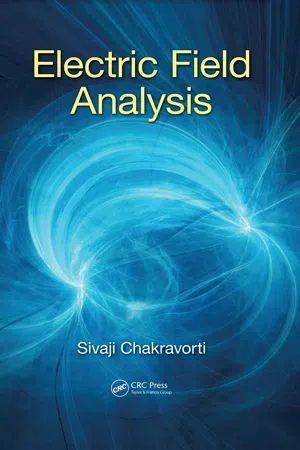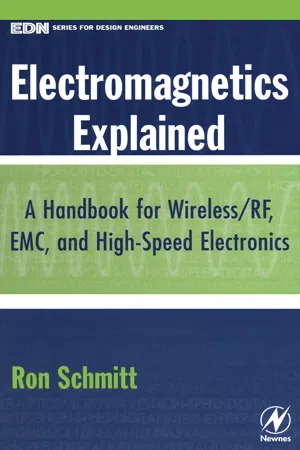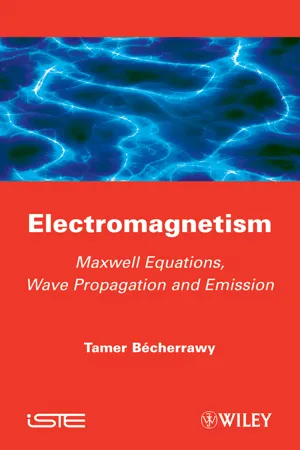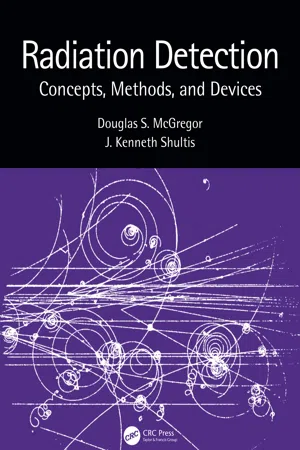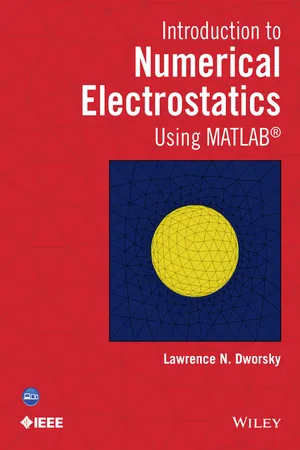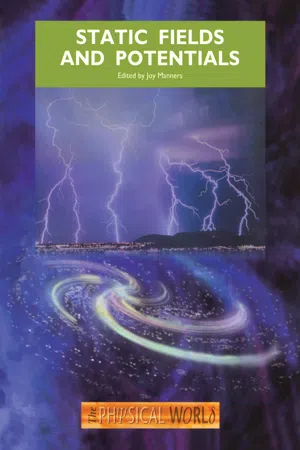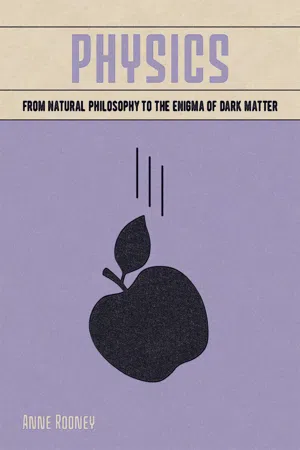Physics
Electric Field Energy
Electric field energy refers to the potential energy associated with the arrangement of electric charges in an electric field. It is a measure of the work that can be done by the electric field on a charged particle. The energy stored in an electric field is proportional to the square of the electric field strength and the amount of charge present.
Written by Perlego with AI-assistance
Related key terms
Related key terms
1 of 4
Related key terms
1 of 3
11 Key excerpts on "Electric Field Energy"
- eBook - ePub
- Sivaji Chakravorti(Author)
- 2017(Publication Date)
- CRC Press(Publisher)
q is located at a given position within an electric field produced by a system of charges. The test charge will experience a force due to the source charges. If the test charge moves in the direction of the field forces, then the work is done by the field forces in moving the test charge from position 1 to position 2. In other words, energy is spent by the electric field. Hence, the potential energy of test charge at position 2 will be lower than that at position 1. On the other hand, if the charge is moved against the field forces by an external agent, then the work done by the external agent will be stored as potential energy of the test charge. Hence, the potential energy of the test charge at position 2 will be higher than that at position 1. Here, it is to be noted that the force experienced by the test charge within an electric field is dependent on the magnitude of the test charge. Hence, the potential energy of the charge at any position is dependent on its magnitude and the distance by which it moves within the electric field.The concept of electric potential is introduced to make it a property, which is purely dependent on the location within an electric field and is independent of the test charge. In other words, it is a property of the electric field itself and not related to the test particle. Hence, electric potential (ϕ) at any point within an electric field is defined as potential energy per unit charge at that point and hence it is a scalar quantity. The unit of electric potential is volt (V), which is equivalent to joules per coulomb (J/C). It is interesting to note that electric field intensity is defined as force per unit charge and electric potential is defined as potential energy per unit charge.However, it is also practically important to note that absolute values of electric potentials are not physically measurable; only difference in potential energy between two points within an electric field can be physically measured; that is, only the potential difference between two points within an electric field is measurable. The work done in moving a unit positive charge from one point to the other within an electric field is equal to the difference in potential energies and hence difference in electric potentials at the two points.FIGURE 1.7 Pertaining to the definition of electric potential.As shown in Figure 1.7 a, consider that a unit positive charge is moved from point 1 to point 2 by a small distance dl . The force experienced by the unit positive charge at point 1 is the electric field intensityE →. Then the potential difference between the ending point 2 and starting point 1 is given byϕ 2-ϕ 1= -E →⋅d l→ ( 1.16 )In the above equationis the work done by the field forces in moving a unit positive charge from point 1 to point 2. In this case, the potential energy of point 2 will be lower than that of point 1 and hence the potential difference (ϕ2 −ϕ1 ) will be negative. For this purpose, the minus sign is introduced on the right-hand side (RHS) of Equation 1.16E →⋅d l→ - eBook - ePub
Dielectrophoresis
Theory, Methodology and Biological Applications
- Ronald R. Pethig(Author)
- 2017(Publication Date)
- Wiley(Publisher)
vice versa. This is why Feynman knew he could stand stock still during his demonstration.Feynman's lecture concerned the action of the earth's gravitational field on an object having mass. An electrical force shares the same property as a gravitational force in being a reversible, conservative, force. The purpose of this chapter is to describe how the concepts of a conservative force and the work-energy theorem, widely used in the subject of mechanics, are also relevant to understanding an electrokinetic effect such as dielectrophoresis.4.2 Electrical Potential Energy
The concepts of work and potential energy described in Box 4.1 will now be applied to examples of the interaction of electric fields with charged bodies, commencing with the situations described in Chapter 2. In Figure 4.1 , a positively charged particle Q is located in a uniform electric field Ex . There are no components of the field acting along the y- and z-axes.Figure 4.1(a) When a positively charged particle Q moves in the direction of a uniform electric field Ex , the field does positive work on the particle and its potential energy U decreases. (b) If the particle moves in the opposite direction, against the field, the field does negative work and the particle's potential energy increases.Box 4.1 Work, Potential Energy and the Work-Energy Theorem
In the SI system the unit of work is the joule, with dimensions of newton-metre (1 J = 1 N.m). The unit of work is thus the product of the unit of force and the unit of distance. If a constant force F acts on body so that it moves a distance s in a straight line along the direction as the force, the magnitude of the work W done on the body by the force is given by:(4.1)For the general case, where the force is not constant and the body moves at an angle θ to it, the work done is calculated by summing up the product Fcosθ.ds for each incremental distance ds taken along the total displacement between points a and b - eBook - ePub
Electromagnetics Explained
A Handbook for Wireless/ RF, EMC, and High-Speed Electronics
- Ron Schmitt(Author)
- 2002(Publication Date)
- Newnes(Publisher)
* Without any aether, there is no way to measure absolute velocity. All movement is therefore relative.Figure 2.2 Two balls attached by a spring. The spring exerts an attractive force when the balls are pulled apart.VOLTAGE AND POTENTIAL ENERGY
A quantity that goes hand in hand with the electric field is voltage. Voltage is also called potential, which is an accurate description since voltage quantifies potential energy. Voltage, like the electric field, is normalized per unit charge.Voltage = Potential energy of a unit chargeIn other words, multiplying voltage by charge gives the potential energy of that charge, just as multiplying the electric field by charge gives the force felt by the charge. Mathematically we represent this byPotential energy is always a relative term; therefore voltage is always relative. Gravity provides a great visual analogy for potential. Let’s define ground level as zero potential. A ball on the ground has zero potential, but a ball 6 feet in the air has a positive potential energy. If the ball were to be dropped from 6 feet, all of its potential energy will have been converted to kinetic energy (i.e., motion) just before it reaches the ground. Gravity provides a good analogy, but the electric field is more complicated because there are both positive and negative charges, whereas gravity has only positive mass. Furthermore, some particles and objects are electrically neutral, whereas all objects are affected by gravity. For instance, an unconnected wire is electrically neutral, therefore, it will not be subject to movement when placed in an electrical potential. (However, there are the secondary effects of electrostatic induction, which are described later in the chapter.)Consider another example, a vacuum tube diode, as shown in Figure 2.3 - No longer available |Learn more
- Robert A. Pelcovits, Joshua Farkas(Authors)
- 2023(Publication Date)
- Barrons Educational Services(Publisher)
Recall from mechanics that not all forces have an associated potential energy function; only conservative forces do. Thus, by saying that a potential energy or potential function even exists, we are assuming that the electrostatic force is conservative. This is fairly clear from the fact that Coulomb’s law has the same mathematical form as the universal gravitational force, which we know to be conservative. The fact that we will be able to determine potential functions later in this chapter confirms this assumption.The Relationship Between Potential and Electric Field
We have created electrical counterparts of force (electrical field = force/charge) and the potential energy (potential = potential energy/charge) functions. Therefore, we might expect that mechanics equations that relate force and potential energy have electrical analogs that relate electrical field and potential. Starting with the relationship of potential energy, work, and force,Dividing through by charge yields Recognizing potential on the left and electric field on the right,Relationship between potential difference and electric fieldIn the case where motion is along the x-direction, this equation can be simplified asDifferentiating both sides with respect to x allows us to calculate the electric field from the potential function:Note that if the electric field is constant, we can write this equation asRelationship between potential and electric field with the integration path along the x-axis:(valid only if electric field is constant)Happily, we will be using these one-dimensional equations much more than complicated line integrals. If you understand how to solve problems using the mechanics equation F = −dU/dx, you’re 90% of the way to understanding this equation. (It really amounts to writing the same equation in a more convenient form.)Calculation of Potential Due to a Point Charge by Integration
Unless otherwise stated, it is generally assumed that we take U = 0 (and thus V = 0) at an infinite distance from the source charges. Situations arise when this is not useful, and we let U = 0 wherever it is most convenient for us. Recall that the actual value of U is meaningless; only differences in U have significance. Therefore, we can let U - Nima Gharib, Javad Farrokhi Derakhshandeh, Peter Radziszewski(Authors)
- 2022(Publication Date)
- Elsevier(Publisher)
However, it makes no mention of the test charge Q. The electric field is a vector quantity that varies across points and is governed by the arrangement of source charges as shown in Fig. 3.1 ; physically, E (r) is the force per unit charge that would be exerted on a test charge if placed at P. 4. Continues charge distributions It is worth to emphasize that the electric field, e.g., Eq. (3.4), it is supposed that the field originates from a collection of discrete point charges denoted by q i. Thus, in terms of continues charge distributions, the electric field can be evaluated by the following integral: (3.5) Figure 3.1 Particle location in 3D cartesian system. Figure 3.2 Different types of charge. If the charge is spread along a line with charge/length (see Fig. 3.2B), then, the charge can be evaluated as dq = λdl′. Here, item dl ′ represents a length element along the line. If the charge is smeared across a surface (Fig. 3.2C), then, dq = σda′, where da is an area element on the surface; and if the charge fills a volume (Fig. 3.2D), then dq = ρ dτ ′, where d τ ′ is a volume element. Therefore, the electric field of a line, a surface, and a volume can be formulated as follows, respectively: (3.6) (3.7) (3.8) Eq. (3.8) is sometimes referred to as “Coulomb's law” due to its simplicity in comparison to the original and the fact that a volume charge is the most widespread and realistic situation. Please take notice of the definition of r in the following formulae. Initially, r i denoted the vector between the source charge q i and the field point r in Eq. (3.5). Similarly, in Eqs. (3.6)–(3.8), r denotes the vector connecting dq (and hence dl′, da′, or dτ′) to the field point r. 5. Field lines, flux, and Gauss's law In theory, we have concluded our discussion of electrostatics. Eq. (3.8) demonstrates how to calculate the field of a charge distribution, and Eq. (3.3) demonstrates how to calculate the force acting on a charge Q placed in this field- eBook - ePub
Electromagnetism
Maxwell Equations, Wave Propagation and Emission
- Tamer Becherrawy(Author)
- 2013(Publication Date)
- Wiley-ISTE(Publisher)
E itself be negligible.From expression [2.3 ] of the force exerted by the point charges qi at ri on q at r, we deduce the electric field produced by these charges E = F/q and we may generalize it to continuous charge distributions; we get[2.5 ]We note that a distribution of point charges qi at points ri may be considered as a volume charge distribution of density is the three-dimensional Dirac function centered at ri (see section A.11 of Appendix A). Similarly, a surface charge density where zn is a coordinate that is normal to the charged surface, and a linear charge density where xn and yn are the coordinates that are normal to the charged line.2.2. Electric energy and potentialThe concept of energy is very important, especially in modern physics, because of its conservation in the case of isolated systems. Energy may have several forms. We are concerned here with the electric potential energy of the charges. The test charge q being subject to the conservative electric force F, the analysis of section 1.4 allows us to define an electric potential energy UE such that It may be shown that the electrostatic interaction of two charges q and qi corresponds to a potential energy In the case of a test charge q = 1 C, F becomes the electric field and the potential energy of the unit charge is the electrostatic potential V such that[2.6 ]The potentials produced by discrete or continuous charge distributions are given by[2.7 ]The SI (Système International, the international system of units) unit of potential is the joule per coulomb (J/C) called the volt (V), and the unit of electric field is the (N/C), which may also be called volt per meter (V/m). In atomic, nuclear, and particle physics, the elementary charge e is frequently used. For this, it is convenient to use the electron-volt (eV) as the unit of energy; this is the energy that is gained or lost by an electron as it moves between two points with a difference of potential of 1 V; thus, , the GeV = 109 eV, and the TeV = 1012 - eBook - ePub
Radiation Detection
Concepts, Methods, and Devices
- Douglas McGregor, J. Kenneth Shultis(Authors)
- 2020(Publication Date)
- CRC Press(Publisher)
potential, which is defined as the potential energy per unit charge,V =U=Q ′14 πϵ o∑i = 1n,Q ir i(8.16) and is expressed in units of volts (or joules per coulomb). Note that the potential is no longer dependent upon the “test” charge Q′ .3 The force exerted upon Q′ may also be expressed in terms of the electric field, produced by one or more point charges, in whichF =. Substitution ofQ ′Einto Eq. (8.13 ) and division by Q′ gives the potential difference between two points within the electric field. Hence, the potential difference between arbitrary locations a and b isq ′EV= Δ V =a b∫ a bE ⋅ d l =∫ a bE cos θ d l .(8.17) In summary, Eq. (8.17 ) is the voltage that an experimenter would measure between two points (a and b) within an electric field. The work done on a unit test charge moving from some point a to another point b in the electric field is Q′ Vab.8.3CapacitanceConsider the arrangement depicted in Fig. 8.6 . Two conductive plates, separated by a distance d, have equal, but opposite, charges. An electric field is produced between the plates by the charges on the plates. The positively charged plate (or terminal) has a voltage V1 and the negatively charged plate has a voltage V2 . The capacitance of the two plates is defined as the ratio of the charge magnitude on either plate to the magnitude of the potential difference between the plates,C =|.Q|Δ V(8.18) If ΔV is taken as the applied voltage V between the electrodes, then the above definition gives the important relationC V = Q(8.19) The SI unit for capacitance is the farad (one coulomb per volt). The reader should understand that the charge stored in a capacitor has a summed positive charge on one terminal and an equal summed negative charge stored on the opposite terminal; hence, a capacitor with stored charge Q actually has +Q on one terminal and −Q - Lawrence N. Dworsky(Author)
- 2014(Publication Date)
- Wiley-IEEE Press(Publisher)
This implies that the electrostatic field is conservative—any path leading from point p back to point p will yield a zero-voltage difference. In other words, electrostatic energy is neither gained nor lost going around a closed path. An important point to make here, even though it is beyond the purview of this book, is that this is not a general electromagnetic system property—it is valid only in the electrostatic case. FIGURE 1.8 Electric field between two large parallel plates, near the center. Restating equation (1.21) to yield the field in terms of the voltage difference, in rectangular coordinates, we have (1.26) The operator ∇ is called the gradient operator. This equation shows clearly why an arbitrary reference voltage choice has no effect on the electric field. Suppose that there is a charge q at the origin of our coordinate system. If q is the only charge present, then no work was required to bring q from anywhere else to the origin. Now, let us bring a test charge from infinity (where the field due to q is zero) to some radius a. Using equation (1.21), we obtain (1.27) and using equation (1.2), the potential at a is (1.28) Equation (1.28) is a scalar equation, which is almost always easier to work with than is a vector equation. Also, once the voltage is known, it is a straightforward job to calculate the field. Consequently, we will concentrate on finding voltages and then (if necessary) finding the field, not the other way around. For the single-point charge of equation (1.28), we already know that the field lines point radially outward (from the charge), going to infinity. Figure 1.9. shows surfaces of constant potential, known as equipotential surfaces or more commonly equipotentials- eBook - ePub
- Jo Verhaevert(Author)
- 2024(Publication Date)
- Routledge(Publisher)
Chapter 3 Electric Fields and Capacitors
DOI: 10.1201/9781003308294-3Learning Outcomes This chapter deals with the laws and properties of electric fields and their application to electric components known as capacitors. On completion of this chapter you should be able to:- Understand the properties of electric fields and insulating materials.
- Carry out simple calculations involving these properties.
- Carry out simple calculations concerning capacitors, and capacitors connected in series, parallel and series/parallel combinations.
- Describe the construction and electrical properties of the different types of capacitor.
- Understand the concept of energy storage in an electric field, and perform simple related calculations.
3.1 Coulomb’s Law
A force exists between charged bodies. A force of attraction exists between opposite charges and a force of repulsion between like polarity charges. Coulomb’s law states that the force, expressed in newtons, is directly proportional to the product of the charges and is inversely proportional to the square of the distance between their centres. So for the two bodies shown in Figure 3.1 , this would be expressed asFigure 3.1 Attraction force between two bodiesF ∝Q 1Q 2d 2In order to obtain a value for the force, a constant of proportionality must be introduced. In this case it is the permittivity of free space, 𝛆0 . This concept of permittivity is dealt with later in this chapter, and need not concern you for the time being. The expression for the force in newtons becomesF =Q 1Q 2ε 0d 2(3.1) This type of relationship is said to follow an inverse square law because F ∝ 1/d2 - eBook - ePub
- Joy Manners(Author)
- 2020(Publication Date)
- CRC Press(Publisher)
V may be positive or negative depending on whether the potential increases or decreases along the direction being considered.In Chapter 1 , you saw that when charge is placed on a body, an electric field is produced in the region around the body. The electric field in turn makes it harder to place more charge of the same sign on the body. Thus, energy is required to establish any particular charge distribution, and this energy can be recovered by allowing charges of opposite sign to be attracted to the charge distribution and neutralize it. As the energy used in establishing a charge distribution is recoverable, it may be described as stored energy. In the rest of this section, you will see how capacitors store electrostatic potential energy by maintaining a separation of positive and negative charges.4.1 Capacitors
The electric potential of a conductor is related to the amount of charge residing on it. The more positive charge there is on a body, the more energy is required to bring up extra positive charge and deposit it on the body.Many electrical circuits contain devices whose primary function is to store energy by separating charge in the circuit. Such devices are called capacitors. A commonly used type of capacitor is the parallel plate capacitor. In its simplest form, this consists of two parallel, conducting plates, each of area A and separated by a distance d, in a vacuum (Figure 2.21 ). A charge q is transferred to one plate and a charge of the same magnitude and the opposite sign is transferred to the other, resulting in a potential difference V between the plates. The ratio of the charge on either of the plates to the potential of that plate relative to the other plate, is called the capacitance of the capacitor, and is denoted by the letter C:C =(2.22)q V.Note that if q is positive, V is also positive, whereas if q is negative, V is negative. The capacitance is, therefore, always positive. Capacitance is a constant that depends on the geometry and materials of the capacitor but is itself independent of the charge q and potential difference V, - eBook - ePub
Physics
From Natural Philosophy to the Enigma of Dark Matter
- Anne Rooney(Author)
- 2020(Publication Date)
- Arcturus(Publisher)
CHAPTER 4Energy fields and forces
When a force acts to move a mass it seems obvious to us that energy is involved. So it may seem surprising that for all the consideration of forces since antiquity, energy was largely neglected by the early natural philosophers. The concept of energy is relatively new, emerging only in the 17th century. Indeed, the term ‘energy’ (from the Greek energia , coined by Aristotle) was only introduced with its modern meaning in 1807 by the genius and polymath Thomas Young (of the double-slit experiment). The most obvious forms of energy are light and heat, both of which come for free from the Sun. Humankind has also harnessed chemical energy (released by burning fuels), the gravitational energy of a falling body, the kinetic energy of wind and moving water, and, latterly, electric and nuclear energy.The conservation of energy
Just as matter is conserved, being neither created nor destroyed, so energy too is conserved. It may be converted from one form to another – and this is how we harness energy to do useful work – but that energy is never actually spent. Galileo noticed that a pendulum converts gravitational potential energy into kinetic energy or the energy of movement. When the pendulum bob is at the high point of its swing it is momentarily still, and has maximum potential energy. This is converted into kinetic energy as the bob moves, and the bob regains potential energy as it climbs up on the other side of its swing.‘There is a fact, or if you wish, a law, governing all natural phenomena that are known to date. There is no known exception to this law – it is exact so far as we know. The law is called the conservation of energy.It states that there is a certain quantity, which we call energy, that does not change in manifold changes which nature undergoes. That is a most abstract idea, because it is a mathematical principle; it says that there is a numerical quantity which does not change when something happens. It is not a description of a mechanism, or anything concrete; it is just a strange fact that we can calculate some number and when we finish watching nature go through her tricks and calculate the number again, it is the same.’
Index pages curate the most relevant extracts from our library of academic textbooks. They’ve been created using an in-house natural language model (NLM), each adding context and meaning to key research topics.
Explore more topic indexes
Explore more topic indexes
1 of 6
Explore more topic indexes
1 of 4
